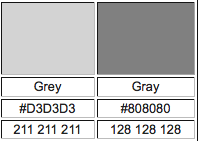In putting together my article on the camera obscura I found myself using the terms grey and gray interchangeably. I discovered a website appropriately named greyorgray.com and it had the following information:
According to a very comprehensive color charted provided by Clorford.com (a trusted resource on color swatches) grey and gray are actually two different "color swatches". According to a survey conducted both in the U.S. and England, many people believe grey is an actual color perceived as the hue of "silver", and gray is a sliding scale of values from black to white.
It also included this helpful mnemonic device: that grAy is used in America and that grEy is generally used in England. My computer, which uses British spelling by preference of my family members with close association to England, always shows "gray" as a misspelling.
Seeing these terms associated with separate colours was new to me. Recently I have come to a new respect for grey working with the camera obscura which reduces chroma and brings neutrality into the image. The human eye is very sensitive to nuances of temperature; a warm grey and a cool grey are easily distinguished even if they are identical in tone. Unfortunately the film camera is not so sensitive and rendered all my greys identically thereby making my photographed work look quite dull.
I was taught not to mix colour with black pigment, a remnant of the Impressionist era when new bright colours were being manufactured and the prismatic palette was used by the majority of painters. My investigations into techniques of past masters led me to use black as part of the earth palette and as a glazing pigment. Black is used in place of blue in the simple four colour palette (yellow ochre, red oxide, white and black) as well as a way to bring down the intensity of the warm colours.
With a broader palette of colours controlling intensity can be brought about in two ways; mixing across the colour wheel using complementary colours, or by mixing colour with grey made from black and white. On the website The Dimensions of Color we find this helpful advice;
Mixing with grey paint is a commonly used strategy for reducing chroma without changing value; when applied to high chroma paints some adjustment is needed to counter the small darkening that occurs. Mixing with grey is commonly also accompanied by a shift in hue, generally in the same direction as that seen in mixing with white paint. These shifts are accentuated if the grey is somewhat bluish, as results from mixing most black paints with white. A perfectly neutral grey (made for example using raw umber plus a black as the darkener) will eliminate this latter component of the shifts, but not the hue shifts that are due to the undertones of the coloured paints. Using a grey to reduce chroma is an important tool that keeps the painter in control of the value of the mixture, whereas the traditional recipe of mixing with the complementary tends to surrender control of the value to the paint.
I have been making a tonal scale of neutral greys and mixing them with my colour. If you need a neutral yellow and a neutral pink for instance to sit side by side in a visual plane this is easily accomplished by mixing them with the same value of grey to bring them into close approximation. Mixing them with their complementary colour means darkening the yellow with purple and bringing the red toward brown with green. It is much less efficient than simply mixing with grey.

